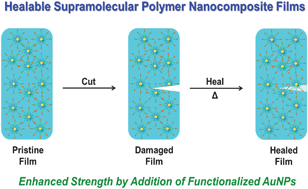A new, healable, supramolecular nanocomposite material has been developed and evaluated. The material comprises a blend of three components: a pyrene-functionalized polyamide, a polydiimide and pyrene-functionalized gold nanoparticles (P-AuNPs). The polymeric components interact by forming well-defined π–π stacked complexes between π-electron rich pyrenyl residues and π-electron deficient polydiimide residues. Solution studies in the mixed solvent chloroform–hexafluoroisopropanol (6 : 1, v/v) show that mixing the three components (each of which is soluble in isolation), results in the precipitation of a supramolecular, polymer nanocomposite network. The precipitate thus formed can be re-dissolved on heating, with the thermoreversible dissolution/precipitation procedure repeatable over at least 5 cycles. Robust, self-supporting composite films containing up to 15 wt% P-AuNPs could be cast from 2,2,2-trichloroethanol. Addition of as little as 1.25 wt% P-AuNPs resulted in significantly enhanced mechanical properties compared to the supramolecular blend without nanoparticles. The nanocomposites showed a linear increase in both tensile moduli and ultimate tensile strength with increasing P-AuNP content. All compositions up to 10 wt% P-AuNPs exhibited essentially quantitative healing efficiencies. Control experiments on an analogous nanocomposite material containing dodecylamine-functionalized AuNPs (5 wt%) exhibited a tensile modulus approximately half that of the corresponding nanocomposite that incorporated 5 wt% pyrene functionalized-AuNPs, clearly demonstrating the importance of the designed interactions between the gold filler and the supramolecular polymer matrix.

This article is Open Access
 Please wait while we load your content...
Something went wrong. Try again?
Please wait while we load your content...
Something went wrong. Try again?


 Please wait while we load your content...
Please wait while we load your content...